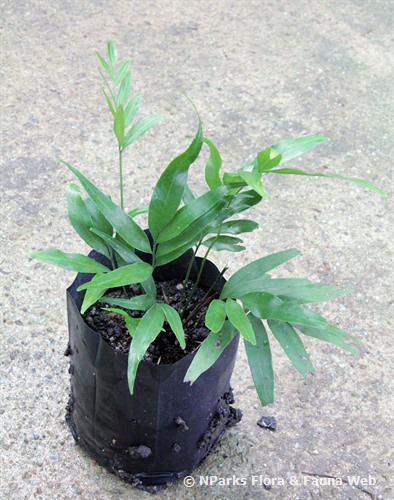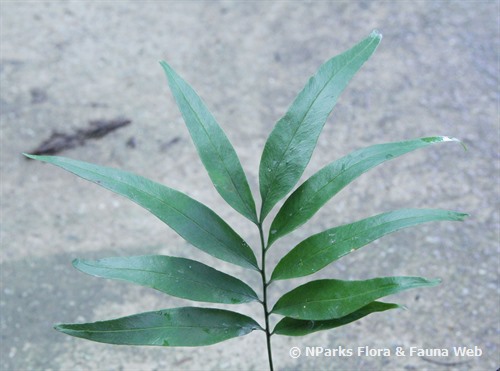
Back
Taenitis blechnoides (Willd.) Sw.
| Family Name: | Pteridaceae |
| Synonyms: | Pteris blechnoides (Willd.) |
| Common Name: | Ribbon Fern, Paku Balu, Paku Pasir, Paku Pijai, 竹叶蕨 |
Name
Classifications and Characteristics
| Plant Division | Ferns & Lycophytes (Non-Seed Vascular Plants) (Fern) |
|---|---|
| Plant Growth Form | Herbaceous Plant |
Biogeography
| Native Distribution | Southeast Asia, Pacific Islands |
|---|---|
| Native Habitat | Terrestrial |
| Preferred Climate Zone | Tropical |
| Local Conservation Status | Native to Singapore (Least Concern (LC)) |
Description and Ethnobotany
| Growth Form | It is a glabrous creeping fern with long rhizomes about 4-5 mm in diameter, with dark brown to black stiff bristles. |
|---|---|
| Foliage | Fronds are simple pinnate, measuring about 20 - 40 cm long and 20 - 30 cm across. Each frond has 1 - 8 pairs of pinnae. Pinnae are linear in shape, gradually narrowing down to the leaf tip, forming a caudate to acuminate apex. It has leaf margins that are smooth or slightly wavy, occasionally involute (leaf margin rolls in toward the underside). They can reach up to 25 × 3 cm. Fertile pinnae are narrower and firm as compared to sterile pinnae (up to 5cm broad). Petioles are either green or straw-like, turn purplish to brown near the base of the plant. Petioles are 30-60 cm long, grooves near the apex become obvious as the plant gets larger. |
| Reproductive Parts - non-flowering plant | Sori are arranged between the costa and the margin of pinna. Sori measures 1–1.5 mm in breadth, rarely interrupted. |
| Habitat | It can be found in lowland to hilly forest up to 750m altitude, lightly shaded areas of primary and secondary forest as well as oil palm plantations. It is tolerant to slightly drier locations than most terrestrial ferns. Rarely found in heavily dense forest. |
Plant Care and Propagation
| Light Preference | Semi-Shade |
|---|---|
| Water Preference | Lots of Water, Moderate Water |
| Plant Growth Rate | Moderate |
Image Repository
Others
| Master ID | 30466 |
|---|---|
| Species ID | 4775 |
| Flora Disclaimer | The information in this website has been compiled from reliable sources, such as reference works on medicinal plants. It is not a substitute for medical advice or treatment and NParks does not purport to provide any medical advice. Readers should always consult his/her physician before using or consuming a plant for medicinal purposes. |


